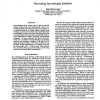Free Online Productivity Tools
i2Speak
i2Symbol
i2OCR
iTex2Img
iWeb2Print
iWeb2Shot
i2Type
iPdf2Split
iPdf2Merge
i2Bopomofo
i2Arabic
i2Style
i2Image
i2PDF
iLatex2Rtf
Sci2ools
AIPS
1994
1994
Becoming Increasingly Reliable
Autonomousmobile robots need to detect potential failures reliably and react appropriately. Dueto uncertainties about the robots and their environment,it is extremelydifficult to design reliable systemsfrom the start. Instead, weadvocatethe structured control methodology,in whichone starts with plans that work in nominalsituations, and then incrementallyadds reactive behaviors to handle previously unanticipated situations. Wehave developed the Task Control Architecture to facilitate this methodologyby enabling monitors and exception handlers to be added to existing hierarchical plans. This paper details the application of this methodologyto a walkingrover and an indoor office robot. In both cases, robot systems were produced that can autonomouslytraverse long distances in obstacle-filled environments.
| Added | 02 Nov 2010 |
| Updated | 02 Nov 2010 |
| Type | Conference |
| Year | 1994 |
| Where | AIPS |
| Authors | Reid G. Simmons |
Comments (0)

